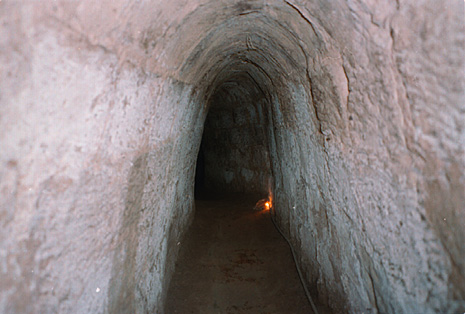50 kilometers of tunnels? Boy, that is an interesting factor for the ground campaign for Israel. Obviously Hamas has been studying tunnels and preparing the battlefield. And like what this great little article talks about, Hamas has learned what they can from Hezbollah and their experiences and they are ready to go.
But back to tunnels. When I think tunnels and warfare, I think of the Cu Chi tunnel complex used during the Vietnam War. Sure there are other famous uses of tunnels in warfare, but the Vietnamese were pretty crafty in this department. Hamas has used their tunnels to smuggle weapons into Gaza, to cross borders to infiltrate martyrdom teams, and set up rocket launching sites that are connected by tunnels for safe launching and easy escape. Of course the launch sites would be set up in civilian areas, to maximize civilian casualties for the retaliatory attacks that would soon follow.
Another use for these tunnels will be for urban warfare. It is quite a thing to fight an enemy that knows how to effectively use tunnels. If the things are deep enough, none of these air strikes will touch them. Hamas can also plant IED’s via tunnels, so they can take out tanks and other vehicles. I also imagine that much of their munitions are deep underground as well. And like the Vietnamese, Hamas makes their own munitions as well. If they have the ability to launch 200 rockets a day, that means they have a very accelerated and advanced manufacturing and smuggling operation going on.
So what does this mean for the Israelis? Time to break out the flashlights, pistols, and the camera robots, and get underground to clear these things. That’s if they can find all of these tunnels. It will take careful searches to find these things, and rear security could be an issue. Perhaps ground penetrating radar will be used, and I am sure tunnels will be just one of the multitude of concerns that the Israelis will have for the ground invasion. –Matt
——————————————————————-

Mai Chi Tho, a political commissar stationed in Cu Chi describes the region as a “springboard for attacking Saigon.” He goes on to say: “We used the area for infiltrating Saigon-intelligence agents, part cadres, sabotage teams. The Tet Offensive of 1968 was prepared and the necessary troops and supplies assembled in the Cu Chi tunnels.” By 1965, there were over 200 kilometers of connected tunnel.
Analysis: The Hamas army
Dec. 27, 2008
Yaakov Katz , THE JERUSALEM POST
Hamas, once known for its suicide attacks inside Israeli cities, is no longer a small-time terrorist group, but a large guerrilla army that has well-trained forces deployed throughout the entire Gaza Strip.
Were the IDF to embark on a ground operation in Gaza, it would face an army of close to 20,000 armed men, among them at least 15,000 Hamas operatives. The rest are from Islamic Jihad, the Popular Front for the Liberation of Palestine and the Popular Resistance Committees.

